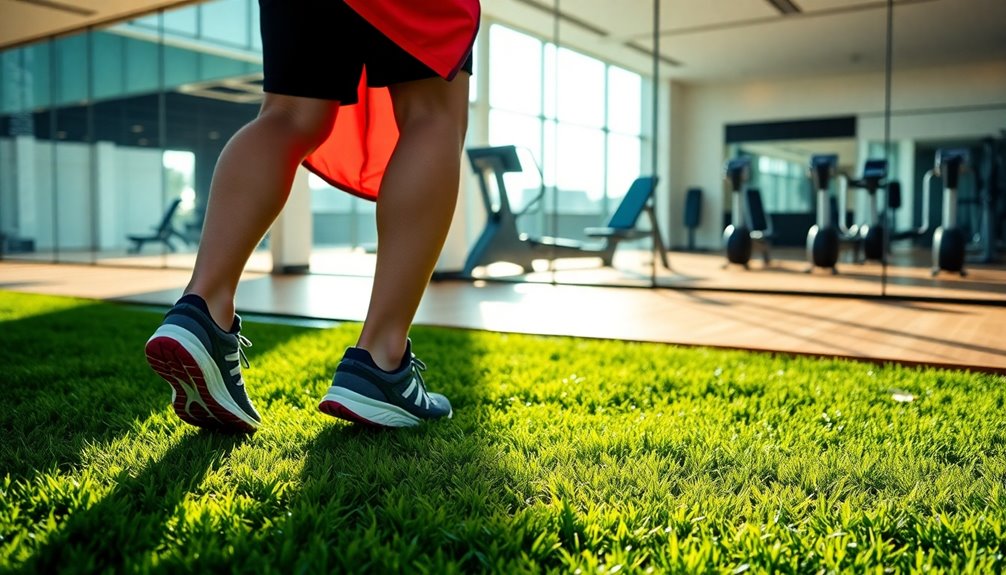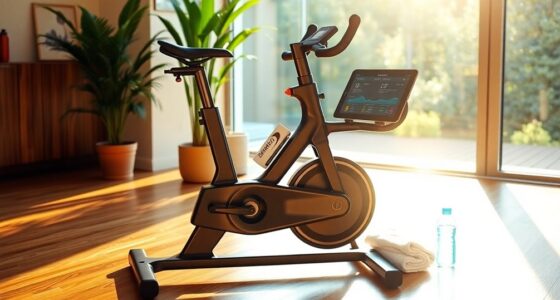To shift seamlessly from outdoor to indoor training, start by setting specific goals to stay focused during the winter months. Adjust your bike setup for comfort and create a ventilated, dedicated training space. Incorporate structured workouts and gradually increase your intensity to maintain your endurance. Mix up your routine with virtual rides or different workout styles to keep it interesting. There's more to explore to make your indoor cycling experience even more effective and enjoyable.
Key Takeaways
- Set specific goals for indoor training to maintain focus and motivation during the transition from outdoor cycling.
- Adjust your bike setup for comfort, ensuring proper saddle position and hand placements to enhance your indoor experience.
- Gradually transition your workouts to maintain performance levels, allowing your body to adapt to the controlled environment of indoor cycling.
- Incorporate structured workouts and varied training styles, like HIIT, to keep sessions dynamic and engaging.
- Create a dedicated training space with good ventilation and hydration to optimize your indoor cycling environment.
Transitioning to Indoor Training – What to Know Before You Start

As you shift to indoor training, it's important to set specific goals to keep you focused during the winter months. Consider aiming to build base fitness or improve endurance through structured training sessions. This clarity helps maintain motivation and direction.
Prepare yourself mentally for the static nature of indoor cycling, as mental toughness is essential to overcoming the monotony of indoor workouts. Adjust your bike setup for comfort by modifying saddle position and hand placements, ensuring you can ride effectively.
Create a dedicated training environment with proper ventilation and hydration to enhance your experience. Finally, establish a pre-ride ritual to signal training time, helping you build consistent habits and stay committed to your indoor training journey. Incorporating regular physical activity can also boost your overall health and enhance your indoor training results.
Different Types of Indoor Cycling Setups – Which One Is Right for You?
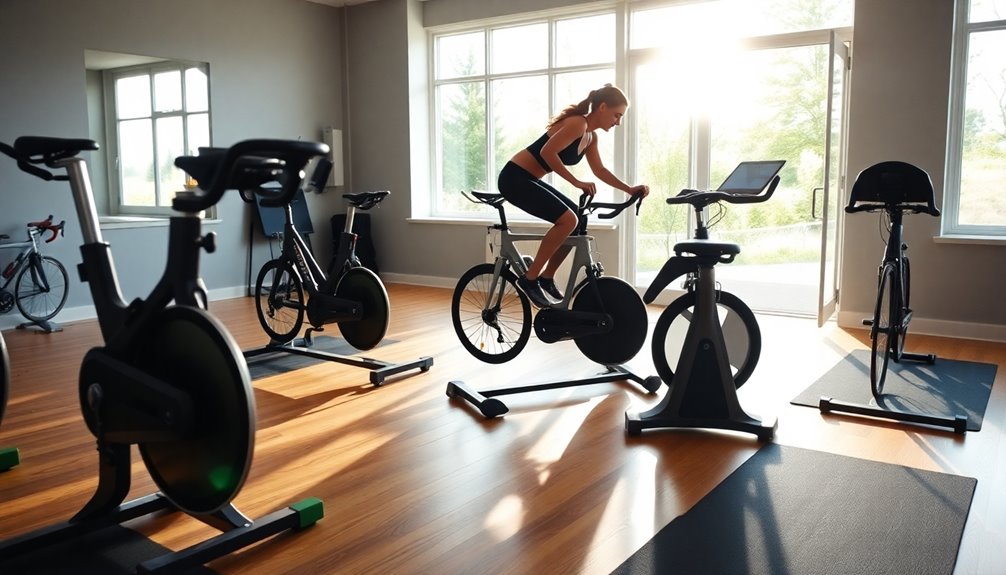
When it comes to indoor cycling setups, you have a range of options to evaluate.
Each type, from direct-drive trainers to rollers, offers unique benefits tailored to different needs and skill levels.
Let's explore which setup might be the best fit for your training goals.
Trainer Types Overview
- Direct-Drive Trainers: Offers precise power measurement and realism—ideal for serious athletes.
- Wheel-On Trainers: Affordable and easy to set up but less accurate in power output.
- Rollers: Improve balance and pedal strokes, though they come with a steep learning curve.
- Hybrid Trainers: Combine stability with a natural riding experience.
If you prefer a more interactive session, consider a smart trainer, which adjusts resistance automatically for an immersive workout. Additionally, engaging in continuous learning ensures you stay updated on the latest training technologies and techniques.
Choose wisely to elevate your indoor cycling journey!
Choosing Based on Needs
Finding the right indoor cycling setup is essential for maximizing your training experience and meeting your fitness goals.
If you're serious about accuracy, a direct-drive trainer is your best bet, giving you precise power measurement and a realistic ride feel.
For beginners, wheel-on trainers offer a more affordable and user-friendly option, although they may lack some accuracy.
If you're looking to enhance your skills, rollers can improve balance and pedal stroke efficiency but come with a learning curve.
Hybrid trainers provide a nice balance between ease of use and skill development.
Finally, smart trainers adjust resistance automatically, creating a more immersive experience, while classic trainers are better for those who prefer hands-on cycling training.
Choose based on your needs!
Popular Indoor Cycling Trainers to Consider
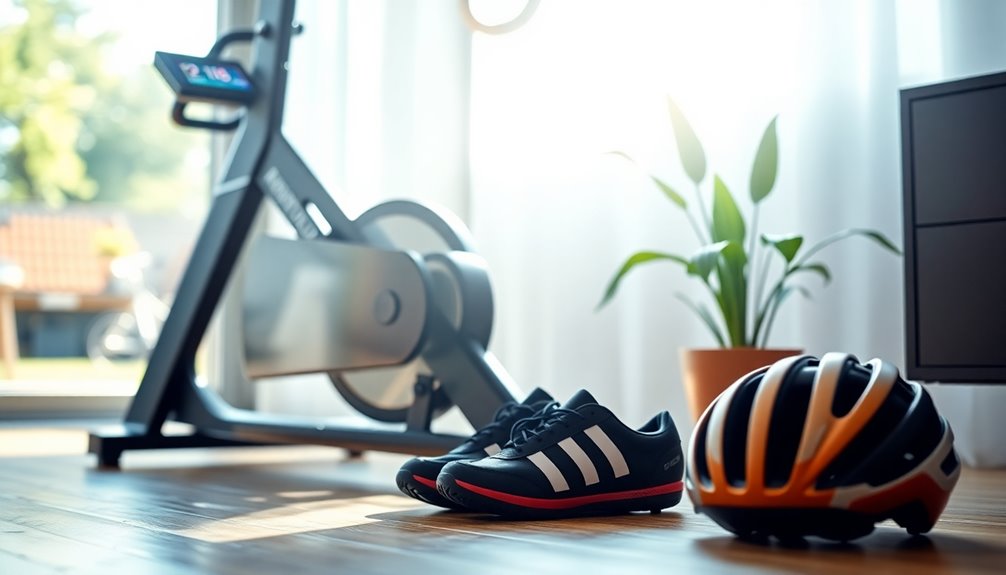
As you explore the world of indoor cycling, you'll discover a range of trainers designed to suit different needs and budgets. Choosing the right one can enhance your training experience and keep you motivated.
Here are some popular options to take into account:
- Direct-drive smart trainers (e.g., Wahoo KICKR, Tacx NEO 2T): Ideal for serious cyclists, offering precise power measurement and a realistic ride feel.
- Wheel-on trainers (e.g., Saris H3): Affordable and easy to set up, perfect for beginners venturing into indoor cycling.
- Rollers: Enhance balance and pedal stroke efficiency, though they require a steeper learning curve.
- Hybrid trainers: Combine the stability of wheel-on trainers with the experience of rollers, providing versatility for all types of riders.
Choose wisely to guarantee your shift from outdoor to indoor training is seamless!
Virtual Cycling Training Platforms – Which One Should You Choose?
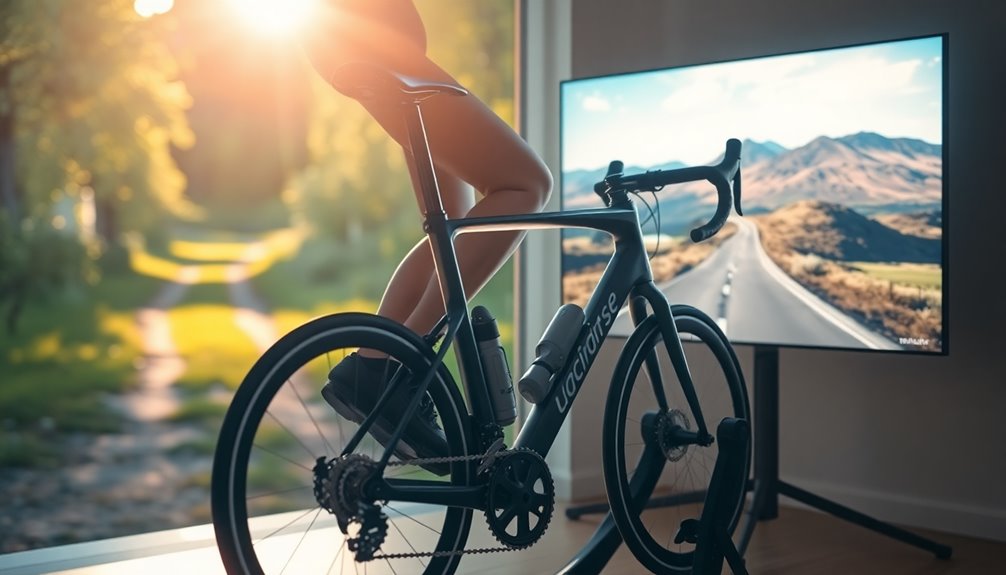
Which virtual cycling training platform fits your style and goals?
Explore the perfect virtual cycling platform that aligns with your training style and goals for the ultimate indoor experience.
If you're looking for social interaction during indoor training, Zwift could be your best bet with its immersive experience and vibrant community for $14.99/month.
For those focused on performance tracking and structured plans, consider TrainerRoad at $19.95/month.
If you want a mix of experiences, Wahoo X offers versatile training for $14.99/month or $149/year.
Rouvy stands out with real-world routes and augmented reality, also at $14.99/month, giving you that outdoor riding feel indoors.
Finally, if you're on a budget, MyWhoosh is free and emphasizes esports racing, adding a competitive edge with cash prizes.
Additionally, selecting the right platform can enhance your training preferences, leading to improved performance and enjoyment. Choose wisely based on your training preferences!
Staying Motivated During Indoor Cycling

Staying motivated during indoor cycling can be a challenge, but there are plenty of strategies to keep your energy high and your mind engaged.
Here are some highly effective ways to stay on track:
- Engage with audio: Use podcasts or playlists to enhance your cycling experience and reduce monotony.
- Ride with friends: Schedule virtual rides on platforms like Zwift to foster social interaction and accountability.
- Rotate formats: Incorporate different workout styles, such as high-intensity interval training (HIIT), to keep things dynamic.
- Set short-term goals: Establish achievable milestones to create a sense of accomplishment, motivating you through longer sessions.
- Explore parenting resources together to build understanding and strengthen your motivation for maintaining a healthy lifestyle.
Embrace the Ride Indoors and Out
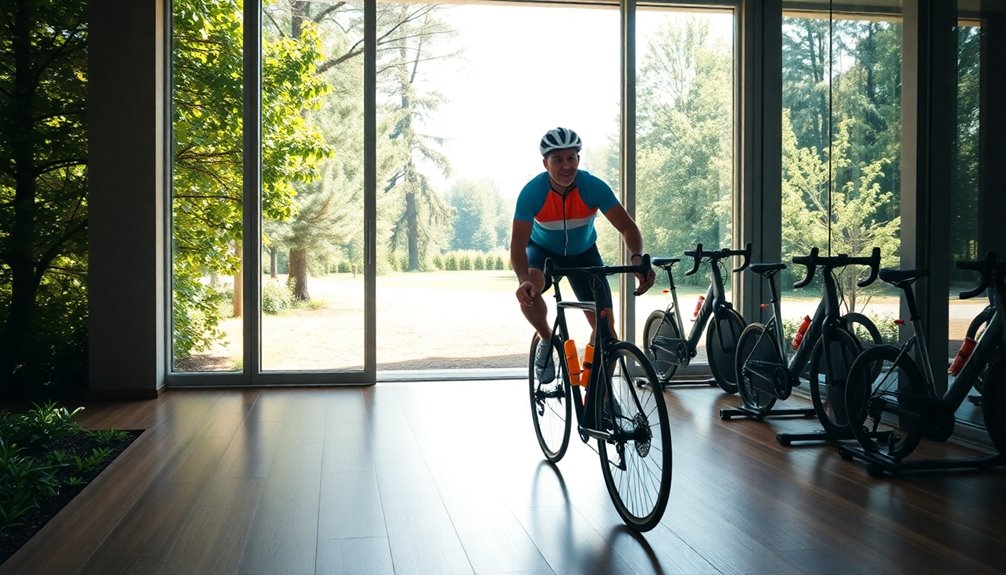
Whether you're cycling through scenic trails or pedaling in your living room, embracing the ride indoors and out can elevate your training experience.
Shifting from outdoor to indoor training doesn't have to be intimidating. Focus on building your base fitness and endurance during winter months, as indoor sessions provide a controlled environment for sustained efforts.
Platforms like Zwift or RGT can simulate riding outdoors and keep your motivation high. Remember to set up a dedicated indoor training space with proper ventilation and hydration to combat physical discomfort.
Regularly monitor your progression levels and adjust your FTP settings to align with your actual capabilities. These adjustments guarantee that your indoor training remains effective and complements your outdoor rides, including your recovery periods.
5 Ways To Transition From Outdoor to Indoor Workouts

As you prepare to move your workouts indoors, it's essential to recognize that the change doesn't have to be abrupt.
Shifting to indoor cycling can be seamless if you follow a few strategies:
- Gradually lower your FTP settings to match indoor demands, as outdoor FTP can be misleadingly high.
- Create a dedicated indoor space with good ventilation to enhance comfort during longer sessions.
- Use engaging platforms like Zwift or RGT to keep your mind active and replicate the social dynamics of outdoor riding.
- Employ smart trainers in non-erg mode to simulate outdoor conditions, making your indoor workouts more dynamic.
Riding Indoors vs. Riding Outside: A Comparison
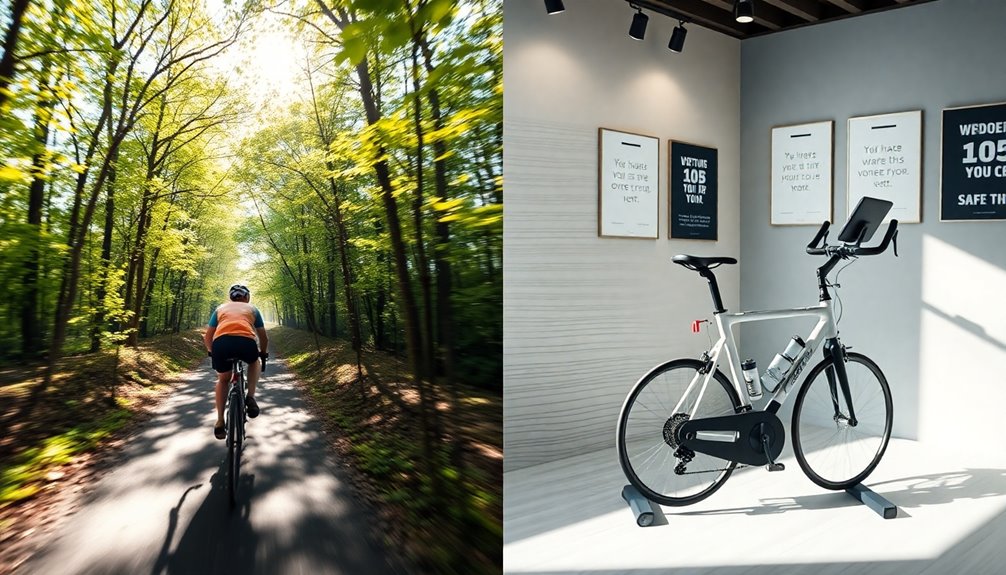
When you ride indoors, you control the environment, which can help you focus on specific training goals without distractions.
In contrast, outdoor cycling exposes you to various elements like wind and terrain, which can challenge your adaptability and resilience.
This difference in conditions also means your power output might vary considerably between the two settings, impacting your overall training effectiveness.
Environmental Factors Impacting Training
Although outdoor cycling offers the thrill of varied terrain and natural challenges, shifting to indoor training presents a unique set of advantages that can enhance your performance.
Indoor training provides a controlled environment, free from unpredictable weather conditions, allowing you to focus on your specific goals. Here are some benefits to contemplate:
- Consistent workouts without road hazards
- Ability to set precise training targets
- No weather-related interruptions or distractions
- Easier adaptation to seasonal changes
While outdoor cycling often yields higher normalized power and FTP readings, indoor training enables you to monitor performance metrics accurately.
This consistency helps guarantee that your training remains effective, even as you adapt to the shift from outdoor to indoor cycling.
Power Output Variability
Indoor training offers a different experience than outdoor cycling, particularly regarding power output variability. While outdoor cycling often results in 15-25% higher Functional Threshold Power (FTP), indoor sessions tend to produce more consistent but lower outputs. Here's a quick comparison:
| Aspect | Outdoor Cycling | Indoor Cycling |
|---|---|---|
| FTP Comparison | 15-25% higher | More consistent |
| Terrain Variability | High (elevation, coasting) | Low (flat, controlled) |
| Normalized Power Variability | Higher (enhanced endurance) | Lower |
| Adjustment Period | N/A | 3-4 weeks |
| Performance Consistency | Variable | Structured |
Understanding these differences helps you adjust your expectations and training strategies as you shift from outdoor to indoor cycling.
Frequently Asked Questions
Is It Better to Cycle Indoors or Outdoors?
Deciding whether to cycle indoors or outdoors depends on your goals and preferences.
If you seek consistent training regardless of weather, indoor cycling's controlled environment is perfect.
However, outdoor riding offers real-world challenges that build resilience and adaptability.
You'll engage different muscle groups and enjoy changing scenery, which can keep you mentally stimulated.
Combining both methods in your routine can help you achieve a balanced and effective training regimen, enhancing your overall cycling experience.
How to Indoor Cycle for Beginners?
You'd think indoor cycling is just pedaling in place, right? It's much more than that!
To start, set specific goals like improving endurance or building fitness. Choose a smart trainer for accurate feedback or a budget-friendly option.
Create a comfortable space with good ventilation and hydration. Keep it interesting with music or virtual platforms.
Finally, mix endurance rides, HIIT, and recovery days to make your sessions balanced and effective. Enjoy the ride!
How to Transition From Indoor to Outdoor Running?
To shift from indoor to outdoor running, start by gradually increasing your distance by 10% each week. This helps your body adapt to the new terrain.
Keep an eye on the weather, as temperature and humidity can affect your performance.
Mix indoor and outdoor workouts for a few weeks to ease into it.
Finally, adjust your pace, since outdoor conditions like wind and uneven surfaces can make running feel different.
Are Indoor Workouts on Your Bike Trainer Are an Excellent Way for Beginners and Cycling Pros to Build Strength Agility and Endurance?
Indoor workouts on your bike trainer are like a secret weapon in your fitness arsenal.
They're an excellent way for both beginners and cycling pros to build strength, agility, and endurance. With structured workouts, you can focus on your specific goals while avoiding outdoor distractions.
Plus, the ability to track precise metrics helps you push your limits, making each session a step closer to peak performance.
Embrace the challenge, and watch your cycling skills soar!
Conclusion
As you embrace the shift from outdoor to indoor training, remember the wisdom of Odysseus: it's not just the journey, but how you navigate it. By choosing the right setup, finding your motivation, and engaging with the community, you can transform your indoor experience into a rewarding adventure. So, pedal through the stormy seas of uncertainty, and you'll discover that the ride indoors can be just as exhilarating as the open road. Keep pushing forward!
